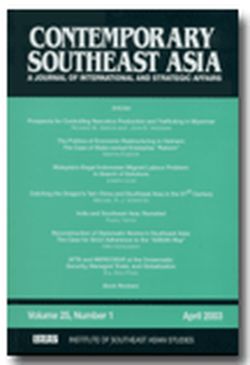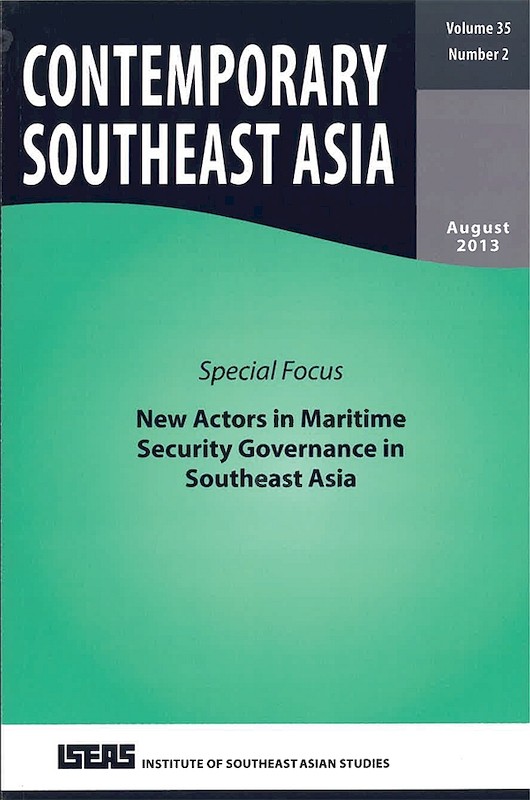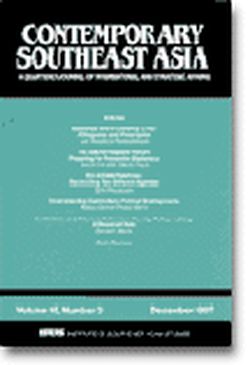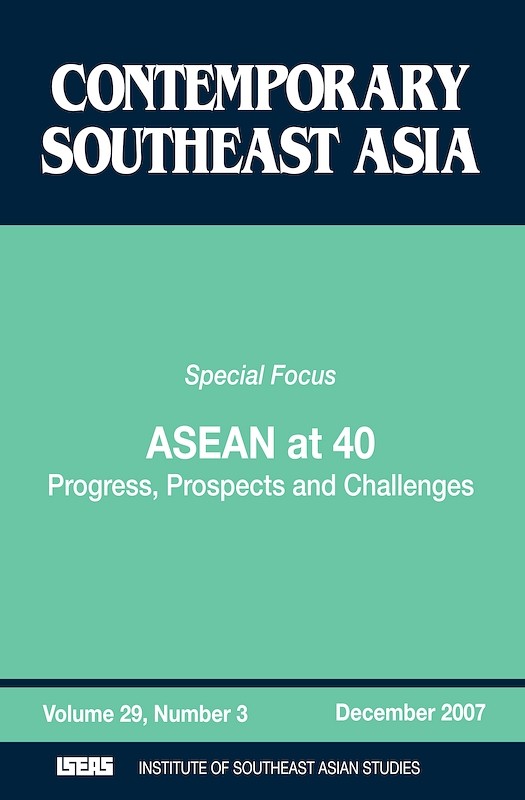Contemporary Southeast Asia: A Journal of International and Strategic Affairs Vol. 25/1 (Apr 2003)

Date of publication:
May 2003
Number of pages:
173
Code:
CS25/1
About the publication
An internationally refereed journal that specializes in the politics, international relations and security-related issues of Southeast Asia and the Asia-Pacific.
Contents
-
Contemporary Southeast Asia: A Journal of International and Strategic Affairs Vol. 25/1 (Apr 2003)
-
Preliminary pages
- ARTICLES
-
Prospects for Controlling Narcotics Production and Trafficking and Myanmar, by Richard M Gibson, John B Haseman, authors see abstractThe problem of narcotics trafficking (and more recently, methamphetamine production and trafficking) in Myanmar has been a regional and international problem for decades. The issue must be approached as an economic and social problem rather than a political or military one. The approaches must be multinational and multi-disciplinary, taking into account the economic, commercial, political, and social issues that force the cultivation of the opium poppy and the production of illegal drugs in the Shan State. This multi-dimensional approach is preferable whether the present military government or a democratic alternative holds power in Yangon. The problems include the lack of viable alternative crops, non-existent transportation, the problem of armed gangs (whether ethnic or economic in nature), the lack of government presence, and the historical inability of the Myanmar armed forces to control the region.
-
The Politics of Economic Restructuring in Vietnam: The Case of State-owned Enterprise Reform, by Martin Painter, author see abstractState-owned enterprise (SOE) reform is a key element in the Vietnamese Governments programme of doi moi, under which marketization and integration into the global economy are occurring. However, party policy prescribes a continuing strategic economic role for SOEs. Equitization is confined mainly to smaller or loss-making enterprises, while the state sector is undergoing various forms of commercialization. Many observers, particularly advocates of privatization, note the slow implementation and apparent incoherence of restructuring policies since 1987, and point to reform failure and a weak state. On the contrary, the state is successfully managing a complex domestic political process in which state business interests defend their commercial privileges against unwelcome restructuring proposals. At the same time, central state actors are deflecting demands from international donors for more rapid reform, while using aid and technical assistance to strengthen state control. In the process, a considerable degree of commercial restructuring seems to be taking place. Apparent gaps in hierarchical control and policy incoherence mask a situation in which a variety of state and party actors with conflicting interests find mutual accommodation within a broad framework of party-sanctioned policy settings.
-
Malaysia's Illegal Indonesian Migrant Labour Problem: In Search of Solutions, by Joseph Chinyong Liow, author see abstractThe influx of illegal Indonesian migrant labour into Malaysia continues to be a source of bilateral friction for Malaysia-Indonesia relations. This article argues that long-term solutions to the problem of illegal Indonesian labour remain illusive because of the lack of political will on the part of both governments to compromise. The article begins by exploring the historical background to Indonesian migration into the Malay Peninsula. It then proceeds to discuss the securitization of the illegal Indonesian migrant worker issue by the Malaysian Government and media, and how this has framed Malaysian perceptions of Indonesian workers. Finally, it concludes by examining the problems and prospects for a long-term resolution of this enduring problem.
-
Catching the Dragon's Tail: China and Southeast Asia in the 21st Century, by Michael R J Vatikiotis, author see abstractRelations between China and ASEAN have become critical as the ten Southeast Asian nations face the challenge of proximity to an emerging superpower. In the modern context, China is often viewed as a threat to Southeast Asia on account of its growing economic preeminence and presumed expansionist aspirations. However, many countries in the region view relations through a more benign historical prism, one that reflects on China as an arrogant but benign partner, from which the commercial advantage was mostly in favour of the Southeast Asian states. The case of Thailand is instructive because of the much longer history of close ties, both in the historical and modern period. Thailand is moving ever closer to China under the present government, and this is having a distinct impact on Thai culture and policy. And while China does appear to be trying to expand its influence on mainland Southeast Asia, seeing Thailand as a key ally, there is an instinctive reflex on the part of the Southeast Asian states to seek a strategic balance in their economic and political ties.
-
India and Southeast Asia: Revisited, by Faizal Yahya, author see abstractIn November 2002, the Association of Southeast Asian Nations (ASEAN) held its first summit with India in Cambodia. This article examines whether the ASEAN India Summit could be considered as a successful outcome of India's engagement strategy with Southeast Asia through its 'Look East' policy. The diplomatic overtures and actions by India to cultivate the Southeast Asian region were clearly visible when Indian Prime Minister Vajpayee visited the Southeast Asian region several times in 2001. The article argues that India's Look East policy has been mainly reinvigorated by China's interests in ASEAN's riparian states along the Mekong River, namely, Cambodia, Laos, Myanmar, Thailand, and Vietnam. With the inclusion of Myanmar in ASEAN in 1997, India has come to share a common land border with an ASEAN member state and this has increased India's potential influence in the region.
-
Reconstruction of Diplomatic Norms in Southeast Asia: The Case for Strict Adherence to the ASEAN Way, by Hiro Katsumata, author see abstractThis article discusses the development of the ASEAN Way. It argues that the basis of the ASEAN Way is constituted by global norms, such as the principle of non-interference. Yet the Southeast Asian countries have incrementally reconstructed these ideational elements in the Asian context, thereby developing the ASEAN Way, through a process of interaction over decades. This process has been affected by the particular political factors in Southeast Asia: the ASEAN countries particular concerns over state sovereignty, and their policy priorities in maintaining their domestic stability. The argument described above leads to the conclusion that the recent suggestions for a flexible interpretation of the ASEAN Way are premature. This is because the political factors which affected the development of the ASEAN Way have not changed much.
-
AFTA and MERCOSUR at the Crossroads: Security, Managed Trade, and Globalization, by Eul-Soo Pang, author see abstractSmall and medium-sized free trade agreements have inherent difficulties in growth and expansion in the global economy which amounts to more than US$30 trillion. Neo-mercantilist ASEAN's share of the global exports was 6.5 per cent in 2000, while that of neo-liberal MERCOSUR was less than 2 per cent. Furthermore, the trade within ASEAN has not been growing for the past three decades, averaging about 20 per cent of the total volume. MERCOSURs average has been on par with ASEAN's. This article argues that the two regional markets have reached the optimum point of intra-regional trade creation under the existing political economy models. Post-September 11 security issues are further complicating the regional integration. The two regions need to revisit the existing inter-state alliance structure and invent new security regimes. The alternative is not whether the two regions must retain neo-mercantilism or reject neo-liberalism; rather it is how to blend the two systems so that the model can satisfy the domestic political needs and at the same time enable economic growth in the next phase of globalization.
- BOOK REVIEWS
-
BOOK REVIEW: The European Union, United States and ASEAN: Challenges and Prospects for Co-operative Engagement in the 21st Century, edited by K.S. Nathan, by Richard Stubbs, author
-
BOOK REVIEW: Explaining ASEAN: Regionalism in Southeast Asia, by Shaune Narine, by Alan Dupont, author
-
BOOK REVIEW: Malaysia: State and Civil Society in Transition, by Vidhu Verma, by P Ramasamy, author
-
BOOK REVIEW: Peacekeeping in East Timor: The Path to Independence, by Michael Smith and Moreen Dee, by Anthony L Smith, author
-
BOOK REVIEW: Vietnam and Beyond: A Diplomat's Cold War Education, by Robert Hopkins Miller, by David Koh Wee Hock, author





